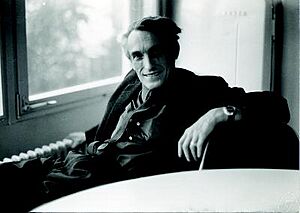Marcel-Paul Schützenberger facts for kids
Quick facts for kids
Marcel-Paul Schützenberger
|
|
|---|---|

Schützenberger in 1972
|
|
| Born | 24 October 1920 |
| Died | 29 July 1996 (aged 75) Paris
|
| Nationality | French |
| Alma mater | University of Paris |
| Known for |
|
| Scientific career | |
| Fields | Mathematics |
| Institutions | University of Paris |
| Doctoral advisor | Georges Darmois Albert Châtelet |
| Doctoral students | Jean Berstel Dominique Foata Alain Lascoux Maurice Nivat Dominique Perrin |
Marcel-Paul "Marco" Schützenberger (born October 24, 1920 – died July 29, 1996) was a smart French scientist. He was a mathematician and also a medical doctor! He studied many interesting things, like how languages work, how to count and arrange things (called combinatorics), and how information is shared.
Besides his amazing work in mathematics, he also had strong ideas about evolution. He disagreed with some common theories, which led to different opinions from other scientists. Many important ideas in math and computer science are named after him, like the Schutzenberger group or the Chomsky–Schützenberger hierarchy. His great-grandfather was also a famous scientist named Paul Schützenberger.
In the late 1940s, he was briefly married to a psychologist named Anne Ancelin Schützenberger.
Contents
Contributions to Medicine and Biology
Marcel-Paul Schützenberger first became a doctor of medicine in 1948. He earned this degree from the Faculté de Médecine de Paris. His special project was about studying statistics of how many boys and girls are born. This work was so good that he won a special award called the Baron Larrey Prize.
A biologist named Jaques Besson, who worked with Schützenberger, said that even though Schützenberger is mostly known for his math, he probably helped bring new ways of using statistics into French hospitals. This helped doctors understand health information better.
Contributions to Mathematics, Computer Science, and Languages
Schützenberger earned his second doctorate in 1953. This time, it was in statistics. His early work helped shape the field of information theory in France. Information theory is about how we can store and send information efficiently.
He also made a big impact on how we understand linguistics (the study of language) and combinatorics (the study of counting and arranging). Two important ideas in language studies, the Chomsky–Schützenberger enumeration theorem and the Chomsky–Schützenberger representation theorem, are named after him. He also has a theorem in combinatorics named after him: the Schützenberger theorem.
With another mathematician, Alain Lascoux, he helped create the idea of the plactic monoid. This is a special math structure. They also invented something called Schubert polynomials.
In the field of automata theory, which is about how machines follow rules, Schützenberger was the first to describe something called weighted automata. These are like simple machines that can calculate a number as an output.
Another mathematician, Dominique Perrin, said that Schützenberger greatly influenced the study of semigroups (a type of mathematical structure). He also made important discoveries about rational functions and transducers, which are advanced math topics.
Where He Taught and His Awards
Marcel-Paul Schützenberger held many important positions during his career:
- Professorships and other teaching
- He was a professor at the University of Poitiers from 1957 to 1963.
- He taught at Harvard University in the Faculty of Medicine from 1961 to 1962.
- He was a Director of Research at the CNRS (a big French research organization) from 1963 to 1964.
- He became a professor at the University of Paris from 1964 to 1970.
- From 1970 until he passed away in 1996, he was a professor at the University of Paris VII.
- National honors
- In 1988, he became a full member of the French Academy of Sciences. This is a very high honor for a scientist in France.
- How He Was Remembered
After he passed away, two important math journals dedicated special issues to him. Theoretical Computer Science did this in 1998, and the International Journal of Algebra and Computation did it again in 1999.
A mathematician named David Berlinski also dedicated his 2000 book, The Advent of The Algorithm, to Schützenberger's memory.
Fun Facts
- A character named "Dr. Schütz" in a 1948 novel by Boris Vian, Et on tuera tous les affreux, was inspired by Marcel-Paul Schützenberger.
- Schützenberger was part of a group of scientists who wrote under a made-up name, M. Lothaire. Many of his students were also part of this group.
His Works
You can find a full list of his papers online. Here are some of his important books and articles:
- De la diversité de certains cancers (About the diversity of some cancers), 1954.
- Théorie géométrique des polynômes eulériens (Geometric theory of Euler polynomials), with Dominique Foata, 1970.
- Triangle de pensées (Triangle of thoughts), with Alain Connes and André Lichnerowicz, published in 2000 after his death.
- Les failles du darwinisme (The miracles of darwinism), an article in La Recherche magazine, 1996.
- Œuvres complètes (Complete Works), a collection of his writings edited by his students, 2009.
You can find his complete works here: Complete Works
See also
- Jeu de taquin

